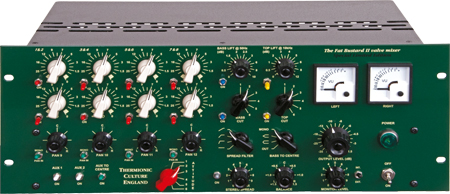Green Fat Bustard Review
Thermionic Culture has made a limited-edition version of its highly regarded Fat Bustard. John Pickford sounds it out.

As the company’s name implies, Thermionic Culture manufactures valve-driven equipment exclusively. Main man Vic Keary has been designing valve gear for over half a century, with one of his earliest presence-boost EQ circuits still employed in the company’s excellent Freebird equalizer. The Fat Bustard summing mixer we have here could be viewed as a link between ancient and modern recording technologies, as many will use it in conjunction with their DAW.
Debate rages on over the relative merits of analogue and digital technology, but it cannot be denied that top-end digital audio kit is now very good indeed. Some would argue that the more pertinent ‘which is better?’ debate is not analogue versus digital, but valves versus solid-state. While transistor-based designs have come a long way over the decades, there is something about the sound of valve gear that leaves many solid-state designs out in the cold.
To The Limit
Wide Boy
The EQ section features stepped rotary pots for both Top Lift and Bass Lift. These boost controls make use of Keary’s varislope EQ curves, as found on Thermionic’s Earlybird mic preamp. At their maximum settings, the bass curve peaks at 50Hz, while the top end peaks at 10kHz. The Bass Cut and Top Cut controls are both six-position stepped switches, with the first three settings operating as 6dB/octave high-pass/low-pass filters respectively, while positions 4 to 6 act as shelving filters. Using the Bass Lift simultaneously with the Bass Cut shelves gives a low-end boost alongside a mid-cut similar to the legendary Pultec EQP 1-A.
Finally, regarding the output section, there is a Balance control, main Output Level stepped switch control and a Monitor output level control. The two outputs are switchable, which is a useful feature for comparing results if an external unit – a compressor, for example – is inserted into the signal path via the jack inputs at the rear.
Sound Magic
Before we started testing we powered up the Fat Bustard and left it to warm for 45 minutes. Our first test was to run several channels of drums, recorded in Logic, into the unit. With the Attitude control at its lowest setting we barely got the VU meters moving at all – this mixer has serious headroom! Leaving the EQ and Stereo Width sections off, we worked our way through each stage of the Attitude control, finding that each step up added a subtle but useful degree of edgy colouration, with the higher settings delivering an upfront sound that really brought out the meaty thwack of the snare while imparting a good degree of weight to the bass drum.
Switching in the EQ, we dialled in some Top Lift and performed the classic ‘low-end trick’ technique of boosting the low frequencies while simultaneously employing one of the Bass Cut filters to reduce low-mid stodge. Further enhancement of our drum mix was achieved by activating the Stereo Spread, incorporating the Spread Filter and Bass To Centre controls. The result was a big, open sound with plenty of clout in the low end.
Melodic instruments and vocals were also processed through the unit, and we were particularly impressed by the way certain elements of a slightly limp-sounding indie/rock recording were brought to life, with the Fat Bustard’s Attitude settings adding a clangourously saturated texture to guitars that suited the track perfectly.
We have been using the unit for several weeks now, both in conjunction with our regular DDA mixing desk/Radar digital recorder setup, and with outside projects recorded in Logic. In all situations, this all-valve analogue mixing tool imparts a rich, full-bodied character that cannot be created by digital means alone.
Thermionic Culture has another winner on its hands with this limited-edition version of the company’s highly regarded Fat Bustard. Anyone wanting to sum digital audio through world-class analogue hardware should seek out one of these units as a priority.
WHY BUY
Stellar valve sound quality
Excellent EQ and stereo-imaging features
Fine construction using high-quality components
Low noise with massive amounts of headroom
WALK ON BY
What’s not to like?
Verdict
Another top-drawer product from valve-design supremo Vic Keary, the Green Fat Bustard is an audiophile-grade, fully featured analogue summing mixer that injects life into sterile digital stems, while the tone and imaging enhancers along with the superb 12AY7, 6SN7 and 12AU7 valves add a wonderful tube character not possible from solid-state devices.
10/10


